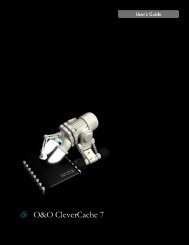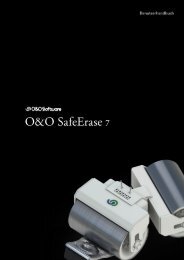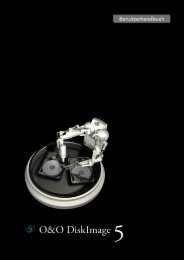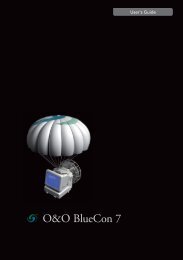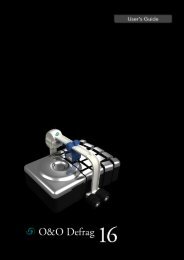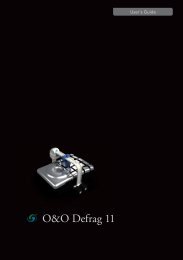O&O DiskImage 7 User's Guide - O&O Software
O&O DiskImage 7 User's Guide - O&O Software
O&O DiskImage 7 User's Guide - O&O Software
You also want an ePaper? Increase the reach of your titles
YUMPU automatically turns print PDFs into web optimized ePapers that Google loves.
Quick Start<br />
One-click imaging - Create an image of the entire computer<br />
One-click imaging is the fastest and easiest way to create a complete image of all your data and settings. One-click<br />
imaging is especially useful if you are using O&O <strong>DiskImage</strong> for the first time, or have not yet created an image of your<br />
computer. Your entire computer including the system partition can be imaged with just one click. The compression<br />
method (LZNT1) and the imaging method (imaging used sectors) are set as default.<br />
Note: We recommend using an external storage medium, e.g. a USB hard disk or a network drive, as target folder<br />
for One-click imaging.<br />
1. Start O&O <strong>DiskImage</strong> and select Drive imaging on the Start page.<br />
2. Now click the symbol Create one-click image in the activity bar.<br />
3. Check to make sure the target path is set to your desired storage location. The [...] button allows you to navigate<br />
to any folder.<br />
4. The image is automatically named after the creation date. You can however enter a name manually.<br />
5. Click Start to begin the imaging process. The imaging process can take some time depending on the size of the<br />
hard disk(s).<br />
Select One-click imaging<br />
Image individual drives<br />
O&O <strong>DiskImage</strong> will let you image individual drives (partitions/volumes). This enables you to image system and data<br />
drives separately from each other. In case of data loss, it then only becomes necessary to restore the data drive. You<br />
don't need to restore your entire computer.<br />
To create an image of one or more drives, please follow the instructions below:<br />
1. In the start page select Drive imaging.<br />
2. Select one or more drives from the drive list. Enable the check next to the drive you want to select.<br />
3. Optionally, you can specify further settings under Imaging options or add the selected activity as Job.<br />
4. To start the imaging process click on Start drive imaging.<br />
5. Enter the target path of the drive on which you want to save the image. You can either accept the suggested<br />
default path or select another location. Under Program settings, you can also select individual default paths.<br />
6. The image is automatically named after the date of creation. You can, however, enter a name manually. All information<br />
from the image will be saved and can later be accessed through Image Information.<br />
7. Select Start. The image file will now be created.<br />
O&O <strong>DiskImage</strong>-20



